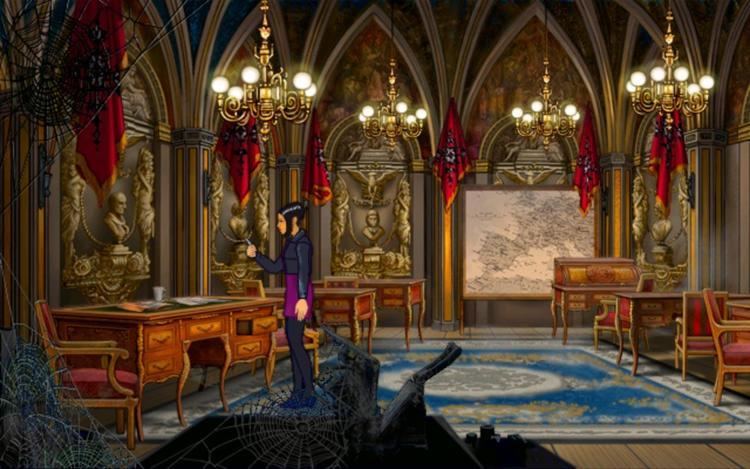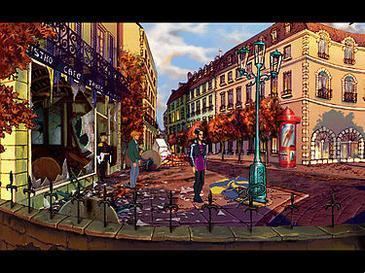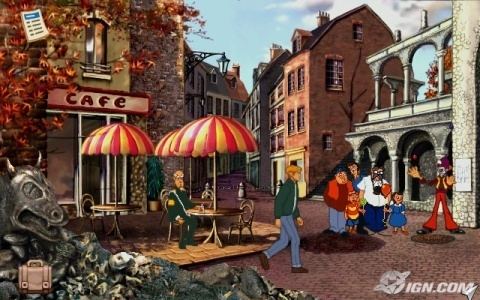 | ||
Platforms Android, Game Boy Advance, iOS, Linux, Mac OS, Nintendo DS, Palm OS, PlayStation, PlayStation 2, PlayStation Vita, Wii, Windows, Windows Mobile, Xbox, Xbox One First release Broken Sword: The Shadow of the TemplarsSeptember 30, 1996 Latest release Broken Sword 5: The Serpent's CurseDecember 5, 2013 Genres Point and click, Adventure game Games Broken Sword 5: The Serp, Broken Sword: Shadow, Broken Sword: The Angel of, Broken Sword: The Sleeping, Broken Sword II: The Smo | ||
Broken sword series review part 1 templars mirror dragon
Broken Sword is a franchise centered on a series of adventure games. The first game in the series, Broken Sword: The Shadow of the Templars, was released in 1996 by English video game company Revolution Software. The first sequel, Broken Sword II: The Smoking Mirror, was released a year later, and was followed by three more sequels: Broken Sword: The Sleeping Dragon in 2003, Broken Sword: The Angel of Death in 2006, and Broken Sword 5: The Serpent's Curse in 2013. A remake of the first game in the series, known as Broken Sword: Shadow of the Templars – The Director's Cut, was released in 2009, and a remake of the second game in the series, Broken Sword: The Smoking Mirror – Remastered, in 2010 (for iOS devices; other platforms followed in 2011).
Contents
- Broken sword series review part 1 templars mirror dragon
- Classic game postmortem broken sword
- Story overview
- The Shadow of the Templars and The Smoking Mirror
- The Sleeping Dragon and The Angel of Death
- The Shadow of the Templars Directors Cut and The Smoking Mirror Remastered
- The Serpents Curse
- Sales and critical reception
- Other media
- Game listings
- Game element listings
- References

The main protagonists of the series are George Stobbart, an American patent lawyer, and Nicole "Nico" Collard, a French freelance journalist, although Nico does not appear as a playable character in the original game The Shadow of the Templars.

The Broken Sword series was originally conceived in 1994 by Charles Cecil, Noirin Carmody and Sean Brennan, while talking about the mythology of the Knights Templar. The first three games in the series were all developed by Revolution Software, while the fourth game was co-developed by Revolution and Sumo Digital. The Shadow of the Templars and The Smoking Mirror were critical and commercial successes, selling millions. However, The Sleeping Dragon and The Angel of Death received mixed reviews and were not as popular as the first two games. This was mainly due to the switch to 3D graphics and that the third game left the "point and click" interface to a more action oriented gameplay. The series appeared on several top adventure game lists. A comic book was produced for each remake of the first two Broken Sword games.

In 2007, it was revealed that a Broken Sword film was in the works and would be produced by CastleBright studios, although there has been no sign of development for many years, which may indicate that the project has been abandoned. However, in 2015, Matt Smalley of Cheltenham, UK, started fund raising on a new planned Broken Sword film. According to Matt Smalley "Fund Raising is going well, I send out at least 50 emails and Facebook posts a week and hope to reach my target amount shortly. But not before sending out some more emails and recurring Facebook posts."

In 2016, the Guinness World Records announced that the Broken Sword franchise now holds the Record for the “Longest running graphic adventure protagonist”. The achievement will be recognised in the next edition of the Guinness World Records Gamer’s Edition 2017.

Classic game postmortem broken sword
Story overview

In The Shadow of the Templars, American George Stobbart, who is touring Europe, is a witness and victim of a bomb attack on a Parisian café "La Chandelle Verte", caused by a clown, later revealed to be a serial killer named Khan, who steals an old man's briefcase and then sets off a bomb inside the café. Shortly after, he meets a French photo-journalist, Nicole "Nico" Collard, a resident of Rue Jarry in Paris, with whom he tries to discover who is responsible for the murder of the old man, Plantard, and while doing so, end up unraveling a conspiracy relating to the Knights Templar. The third and fourth game, The Sleeping Dragon and The Angel of Death, also follow the Templar-related story line: The Sleeping Dragon continuing the story from The Shadow of the Templars with a number of returning characters, while in The Angel of Death, George and Nico, with a newly introduced character Anna-Maria, unravel a mystery related to the Catholic Church. Unlike the other installments, in The Smoking Mirror, George and Nico unravel a Mayan mystery, involving the Mayan god Tezcatlipoca. The Serpent's Curse follows a storyline related to the Gnostic Gospels.
The Shadow of the Templars and The Smoking Mirror
Video game designer, writer and director Charles Cecil began working on the scenario for Broken Sword, Revolution Software's third game following Lure of the Temptress (1992) and Beneath a Steel Sky (1994), in 1992, which would be set in Paris with a Knights Templar storyline. After visiting Paris and reading The Holy Blood and the Holy Grail, Cecil was certain the Templars would be a good subject for a game. Cecil, Dave Cummins and Jonathan L. Howard began work on the story and design. Cecil and Cummins attended a film-writing course and their script was read by senior BBC scriptwriter and dramatist Alan Drury. Steve Ince, who created initial location sketches for the game before working on Beneath a Steel Sky, was promoted to producer halfway through the project. In 1994 Cecil and Noirin Carmody met with Sean Brennan, then-head of publishing at Virgin Interactive, and Virgin agreed to publish the game's PC version, but were not interested in publishing the game on the PlayStation, feeling that only 3D games would sell for the console. As a result, Cecil contacted Sony Computer Entertainment, who agreed to publish the game for the console. Tony Warriner and David Sykes were the game's designer-programmer Carmody the executive producer. The game uses the Virtual Theatre engine, as do Revolution's previous two games.
One of Cecil's goals was to depart from the humour-based adventure games more popular at the time by creating a game with good pacing and a complex storyline, a reason he thought the Knights Templar would be an ideal subject. Broken Sword offered a unique "conversation icon" system which would not reveal to the player what the protagonist was about to say; Cecil's intention was to make the game more cinematic. Although aiming at designing a game with a cinematic feel, Cecil felt the game should not resemble interactive movies of that time, which he felt were "mimicking movies". He wanted to create two protagonists who would exchange ideas, helping drive the game along. He made George American and Nico French to appeal to US and European markets. Revolution believed they needed to utilise the best of other creative industries. Hand drawn artwork was animated by artists including Don Bluth Studios' Eoghan Cahill and Neil Breen and Red Rover Studio's Mike Burgess, resulting in graphics animated in a style resembling classic animated films. The game's final cost was one million pounds.
Broken Sword II: The Smoking Mirror was conceived in 1997, by Cecil and Revolution's crew. The artwork for Broken Sword 2 was developed through a number of stages. Initially pencil drawings were made of characters which were then digitally coloured in, before being cleaned up. The background layouts were produced in a similar way, also starting out as pencil designs. They were all drawn by Eoghan Cahill and Neil Breen, who both previously worked on the original Broken Sword game, while they were now working together with Amy Berenz and Lee Taylor. The music in the game was again composed by Barrington Pheloung, with Bob Sekar adding the closing score. While Rolf Saxon returns to voice actor of George, Jennifer Caron Hall a bilingual actress and daughter of French actress Leslie Caron, was cast as Nico. Theatre director Edward Hall (director) rehearsed the assembled actors and took no more than a week to record the entire game, according to an interview given by Rolf Saxon in 2011 Alternative Magazine The game was first released for Windows on October 31, 1997.
The Sleeping Dragon and The Angel of Death
Revolution first discussed the idea of a third Broken Sword in 2000. At first, The Sleeping Dragon was planned to have similar cartoon-quality visuals to the first two Broken Sword games; however, Revolution decided not to use the "flat" look, claiming it lacked visual depth. The team wanted the game to look believable, but not necessarily realistic, similar to Japanese animated films. Textures were hand drawn to achieve the "cartoon" look, while the light-map employed radiosity to create realistic lighting. Advances in hardware plus the changes in methodology allowed the game to move to 24-bit color. To make the game feel like a film, Revolution brought in a cinematic consultant, Bob Keen, who made sure the game conveyed emotions and atmospheres appropriate for each scene. The music in the game was composed by Ben McCullough. The voice recording was scheduled to take five days; however, the entire process took four days. The voices were recorded with the voice actors together, enabling better getting into their parts. The full script is 6,000 lines in total, similar to Broken Sword II. While Rolf Saxon returns to voice George, Nico was this time played by Sarah Crook. The game's final cost was two million pounds.
Revolution Software and THQ announced Broken Sword: The Angel of Death on August 17, 2005. According to Charles Cecil, the Broken Sword was originally planned to be a trilogy, but that after the release of Broken Sword: The Sleeping Dragon, the demand from fans for a sequel was overwhelming. Though The Sleeping Dragon benefited commercially from being released on console as well as PC, this approach required certain development compromises as the PC version was held back by the constraints of the console versions. As a result, The Angel of Death was written for PC only "so as to really push the boundaries in terms of the technology and graphics." As a series' first, Revolution was not the only developer, but was co-developed by Revolution and Sumo Digital. Cecil believed that because of the requirement for ever larger team sizes, it was no longer possible to maintain a large development team to write single original titles, resulting in Revolution closed the production side in order to concentrate on design, and Sumo to concentrate on production. It is the first game to be amBX enabled. Broken Sword: The Sleeping Dragon was criticised for featuring a high number of action elements. Cecil stated that he aimed to put the player under pressure. While he still stood behind this principle, he thought the action elements were not the right approach. The Sleeping Dragon was also criticised for using a high number of crate puzzles, resulting in Cecil reducing the number of them. The music in the game was composed by Ben McCullough and features tracks by Übernoise. While Rolf Saxon returns to voice George Stobbart, Nicole "Nico" Collard was this time played by Katherine Pageon.
The Shadow of the Templars – Director's Cut and The Smoking Mirror – Remastered
On March 21, 2009, Ubisoft released a special edition of The Shadow of the Templars for the Wii and Nintendo DS. According to Cecil, the Director's Cut came about thanks to a group of Broken Sword fans, who started an online petition begging him to bring the series to the Wii and DS. The game starts a day before the Parisian cafe explosion in the original game, filling in some of Nicole Collard's back-story. Dave Gibbons, with whom Revolution worked previously on their 1994 cult classic adventure Beneath a Steel Sky, worked on visual references for the game; He also produced a comic book to accompany the game's DS release. In the Director's Cut, Hazel Ellerby returns to voice Nicole Collard in the new sections, playing Nico again for the first time since the original game's release. Rolf Saxon, as in every sequel, also returns to voice George Stobbart. Unlike in the original game, players control Nicole Collard for selected game sections. Besides the new character artwork by Gibbons during conversations, the Director's Cut also features a new first person view for certain puzzles. In the DS version, there is no spoken dialogue, only subtitles. A version of the Director's Cut for iPhone and iPod Touch was released on January 20, 2010. In May 2010, a version with higher resolution and a digital comic was released on the iPad. A PC version was released on August 27, 2010 on various digital distribution services.
When considering the project, Cecil played the game again and noticed many issues, including that backgrounds were pixilated, the movies and audio were of poor quality, and he also felt some dialogue was out of place. He thought all these elements could be addressed and improved in a remastered edition, in which they could add a diary, hint system, and new artwork from Dave Gibbons, which they could offer as an interactive digital comic. On December 9, 2010, Revolution Software announced the release of Broken Sword: The Smoking Mirror – Remastered on Apple iOS devices, and was finally released on December 16, 2010. The new features include an exclusive interactive digital comic from Dave Gibbons, fully animated facial expressions, enhanced graphics, high quality music, a context-sensitive hint system, diary, and a Dropbox integration which facilitates a unique cross-platform save-game feature, enabling players to enjoy the same adventure simultaneously on multiple devices. It also featured full Game Center integration – including in-game achievements. The Mac and PC versions followed in early 2011.
The Serpent's Curse
On August 23, 2012, Revolution announced a fifth title in the series, Broken Sword 5: The Serpent's Curse, has been in development for six months and is to return to the series' 2D graphical style with an early 2013 release targeted. Cecil also announced that, despite interest from the "industry's biggest third party publisher," funding for the game's remaining development is to be sought via Kickstarter with a target of $400,000. It received its funding of $771,561 on September 22, 2012.
Sales and critical reception
The Broken Sword franchise is Europe's most successful adventure series, selling six million units; The Shadow of the Templars and The Smoking Mirror are Revolution's best-selling titles, each selling a million copies. With the decline of the adventure genre at the beginning of the 2000s, sales of the Broken Sword series decreased as well, with The Sleeping Dragon and The Angel of Death selling a few hundred thousand copies. During the so-called "adventure renaissance", the two Broken Sword remakes were met with success; in 2011, the Director's Cut and The Smoking Mirror: Remastered sold 500,000 copies on the iOS alone.
The series' installments have received positive reviews, with The Shadow of the Templars often being cited as a classic in the adventure genre, ranking high on various "top" lists. The remakes were met with acclaim, most notably the iOS versions, often called one of the best games on the platform.
Other media
On May 21, 2007, it was announced that Charles Cecil had begun the work of taking the game franchise to the silver screen.
Dave Gibbons produced comics for each remake of the first two Broken Sword games; Broken Sword: The Shadow of the Templars – Director's Cut, and Broken Sword: The Smoking Mirror – Remastered.
On September 28, 2008, mindFactory released a fan-made freeware Broken Sword game, called Broken Sword 2.5: The Return of the Templars.
Game listings
Broken Sword: The Shadow of the Templars
Broken Sword II: The Smoking Mirror
Broken Sword: The Shadow of the Templars – Director's Cut
Broken Sword: The Smoking Mirror – Remastered
Broken Sword 5: The Serpent's Curse
Game element listings
The Goat Puzzle
Barrington Pheloung's "Intro" opening theme
Nicole Collard
Khan
